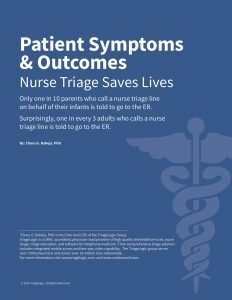Medical Center in Oklahoma Provides and Innovative Triage Line to Manage Hospital overcrowding
An Effective Approach to ER Phone Calls
Emergency Room (ER) overcrowding is widespread in hospitals, creating delays and diversion from those who need care the most. According to a recent article “Compounding the problem is the alarming trend of a decreasing number of ERs and an increasing numbers of ER visits.[1]”
All too often, injury or illness appears without warning for patients. For hospitals trying to control overcrowding, the obvious solution is to redirect patients who do not need to be in the ER to more appropriate paths for care. Who then determines if it is necessary for a patient to go the ER? Most people are not trained medical professionals, and as a result, worry and end up in the ER for non-urgent symptoms.
Patients faced with uncertainty about where to go, all too often, end up calling the ER department and are given a standard response. “We are not allowed to give advice over the phone. If you think you have an emergency, please hang up and call 911. If you think you need to be seen, you can come to the emergency room or call your doctor.”
So, who do you call? One of our hospital clients in Oklahoma, with a similar issue, wanted to change this process.
What if we provided a nurse triage line that would be available to receive calls from the patients calling the ER?
Having the reassurance of a triage nurse could help decrease the number of people in the ER for non-emergency reasons. This would provide patients with quick and easy access to a trained medical professional to assist in determining the appropriate next steps based on their symptoms and medical history.
Also, since the nurses worked independently from the hospital system, the TriageLogic nurses would provide an objective opinion increasing patient trust.

The results were inspiring. The TriageLogic nurses significantly decreased unnecessary emergency room visits.
We conducted a random survey of about 520 patients about their plans before talking to a nurse to determine the effectiveness of the system. Out of 240 patients who were planning to go to the ER, 42% of them were diverted to a lower level of care including 17% that were given home care needing no additional follow up actions. This translated into a savings of at least $215,000 in unnecessary ER visits, not to mention peace of mind for patients being able to stay home and rest.
Better Health Outcomes
The benefits didn’t just stop at ER costs savings. Consider the patients who called into the nurse triage line and were not intending to go to the ER. There are a number of medical conditions considered emergencies because they require rapid or advanced treatments. Surprisingly, close to 20% of the patients who called into the nurse triage line had symptoms that were serious enough to warrant a visit to the ER. Without the TriageLogic nurse line, the outcomes for these patients could have been life threatening or fatal.
Conclusion
While nurse triage has shown significant effectiveness in an outpatient setting, this preliminary data shows even greater promise to expand this model to emergency rooms around the country.
Providing local communities with a nurse triage program not only prevents unnecessary ER visits and save on healthcare costs, but also ensures patients get appropriate care when a serious symptom arises. For the hospital, this increase goodwill in the community while addressing the overcrowding of the ER: a win-win all around.
If you are interested in finding out more about giving your patients access to quality registered nurses after-hours, contact us today!
[1] https://www.ncbi.nlm.nih.gov/pmc/articles/PMC3540619/ and https://www.politico.com/story/2018/06/12/insurers-spark-blowback-by-reducing-emergency-room-coverage-612842






